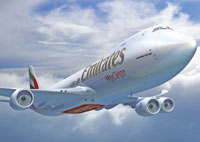Emirates plans eight new passenger destinations

How has 2007 fared for Emirates?
This has been another landmark year for Emirates.
It became the first airline to fly to six continents, when it launched flights to Sao Paulo in October. The service to Brazil marked the first ever non-stop link between South America and the Middle East.
In November at the Dubai Air Show it announced orders for 143 aircrafts worth $34.9 billion, and also committed more than $600 million to equip the existing and future aircraft with the best and latest in-flight products.
Demand for Emirates service has been very strong and is growing. At the half-year mark, Emirates had transported 10.3 million passengers and bettered the six month profits by 90 per cent from last year.
By the end of 2007, Emirates will have received 13 new aircraft including the first Boeing 777-200Lr, launched six new passenger destinations (Venice, Newcastle, Sao Paulo, Toronto, Ahmedabad and Houston) and five freighter only destinations (Djibouti, Hahn, Toledo, Zaragosa and Prague) as well as having pioneered a water limousine airport transfer service in Venice, launched 76 new websites with the latest online booking features and hired over 8000 new staff across the Emirates Group.
What are the company’s plans for 2008?
Emirates has plans to add eight new passenger destinations and dozens more additional flights to existing destinations.
These growth plans will be made possible by the delivery of over 20 new aircrafts during the coming year, including the first A380s.
In the first quarter of 2008, Emirates will move into its new terminal at Dubai International Airport, dedicated to Emirates passengers.
What is the company’s strategy in the face of competition?
There has always been competition, but Emirates has continued to thrive. We believe competition benefits everybody and encourages innovations, Emirates strategy has always been to focus on its key differentiations – quality service, providing convenient ‘one-stop’ connections between almost any two cities in the world via an efficient hub at Dubai International Airport.
Is Emirates bullish about 2008? If yes, why?
Yes, IATA forecasts global air traffic to grow at 5.1 per cent in the next four years and Emirates is well placed to act on the opportunities brought about by the growing demand for air travel.
What can travellers look forward to in the New Year?
More destination choices, more convenient flight connections and more products and service innovations including those that will debut with the opening of the Emirates new terminal at Dubai International Airport and the first A380 delivered in August 2008.
What will be the biggest challenges facing you in the Middle East in 2008?
Like all other airlines, the record high fuel prices will remain the single biggest threat to the airlines bottom line. The other key challenge will be the sourcing of large numbers of skilled professionals for the carriers expanding business as it will continue with its double-digit growth rate for some years to come and each year the growth starts from a higher base. Emirates is well aware of the challenges and has taken concrete measures to address these.
